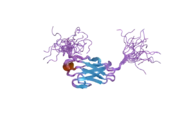| KIRREL3 | |||||||||||||||||||||||||||||||||||||||||||||||||||
|---|---|---|---|---|---|---|---|---|---|---|---|---|---|---|---|---|---|---|---|---|---|---|---|---|---|---|---|---|---|---|---|---|---|---|---|---|---|---|---|---|---|---|---|---|---|---|---|---|---|---|---|
| |||||||||||||||||||||||||||||||||||||||||||||||||||
| Identifiers | |||||||||||||||||||||||||||||||||||||||||||||||||||
| Aliases | KIRREL3, KIRRE, MRD4, NEPH2, PRO4502, kin of IRRE like 3 (Drosophila), Kin of IRRE-like protein 3, kirre like nephrin family adhesion molecule 3 | ||||||||||||||||||||||||||||||||||||||||||||||||||
| External IDs | OMIM: 607761 MGI: 1914953 HomoloGene: 57050 GeneCards: KIRREL3 | ||||||||||||||||||||||||||||||||||||||||||||||||||
| |||||||||||||||||||||||||||||||||||||||||||||||||||
| |||||||||||||||||||||||||||||||||||||||||||||||||||
| |||||||||||||||||||||||||||||||||||||||||||||||||||
| |||||||||||||||||||||||||||||||||||||||||||||||||||
| |||||||||||||||||||||||||||||||||||||||||||||||||||
| Wikidata | |||||||||||||||||||||||||||||||||||||||||||||||||||
| |||||||||||||||||||||||||||||||||||||||||||||||||||
Kin of IRRE-like protein 3 (KIRREL3) also known as kin of irregular chiasm-like protein 3 or NEPH2 is a protein that in humans is encoded by the KIRREL3 gene.[5]
NEPH2 is a member of the NEPH protein family of transmembrane proteins, which includes NEPH1 (KIRREL) and NEPH3 (KIRREL2). The NEPH proteins can interact with nephrin and CASK.
Function
NEPH2 has been implicated in synapse formation.[6] Disruption of KIRREL3 gene function had been associated with abnormal brain function.[7]
NEPH1 and NEPH2 are involved in the blood filtration function of the kidney and are located in the slit diaphragm.[8]
References
- 1 2 3 GRCh38: Ensembl release 89: ENSG00000149571 - Ensembl, May 2017
- 1 2 3 GRCm38: Ensembl release 89: ENSMUSG00000032036 - Ensembl, May 2017
- ↑ "Human PubMed Reference:". National Center for Biotechnology Information, U.S. National Library of Medicine.
- ↑ "Mouse PubMed Reference:". National Center for Biotechnology Information, U.S. National Library of Medicine.
- ↑ "Entrez Gene: kin of IRRE like 3 (Drosophila)".
- ↑ Gerke P, Benzing T, Höhne M, Kispert A, Frotscher M, Walz G, Kretz O (Oct 2006). "Neuronal expression and interaction with the synaptic protein CASK suggest a role for Neph1 and Neph2 in synaptogenesis". The Journal of Comparative Neurology. 498 (4): 466–75. doi:10.1002/cne.21064. PMID 16874800. S2CID 16564474.
- ↑ Bhalla K, Luo Y, Buchan T, Beachem MA, Guzauskas GF, Ladd S, Bratcher SJ, Schroer RJ, Balsamo J, DuPont BR, Lilien J, Srivastava AK (Dec 2008). "Alterations in CDH15 and KIRREL3 in patients with mild to severe intellectual disability". American Journal of Human Genetics. 83 (6): 703–13. doi:10.1016/j.ajhg.2008.10.020. PMC 2668064. PMID 19012874.
- ↑ Neumann-Haefelin E, Kramer-Zucker A, Slanchev K, Hartleben B, Noutsou F, Martin K, Wanner N, Ritter A, Gödel M, Pagel P, Fu X, Müller A, Baumeister R, Walz G, Huber TB (Jun 2010). "A model organism approach: defining the role of Neph proteins as regulators of neuron and kidney morphogenesis". Human Molecular Genetics. 19 (12): 2347–59. doi:10.1093/hmg/ddq108. PMID 20233749.
Further reading
- Davila S, Froeling FE, Tan A, Bonnard C, Boland GJ, Snippe H, Hibberd ML, Seielstad M (Apr 2010). "New genetic associations detected in a host response study to hepatitis B vaccine". Genes and Immunity. 11 (3): 232–8. doi:10.1038/gene.2010.1. PMID 20237496.
- Anney RJ, Lasky-Su J, O'Dúshláine C, Kenny E, Neale BM, Mulligan A, Franke B, Zhou K, Chen W, Christiansen H, Arias-Vásquez A, Banaschewski T, Buitelaar J, Ebstein R, Miranda A, Mulas F, Oades RD, Roeyers H, Rothenberger A, Sergeant J, Sonuga-Barke E, Steinhausen H, Asherson P, Faraone SV, Gill M (Dec 2008). "Conduct disorder and ADHD: evaluation of conduct problems as a categorical and quantitative trait in the international multicentre ADHD genetics study". American Journal of Medical Genetics Part B. 147B (8): 1369–78. doi:10.1002/ajmg.b.30871. PMID 18951430. S2CID 30325260.
- Rose JE, Behm FM, Drgon T, Johnson C, Uhl GR (2010). "Personalized smoking cessation: interactions between nicotine dose, dependence and quit-success genotype score". Molecular Medicine. 16 (7–8): 247–53. doi:10.2119/molmed.2009.00159. PMC 2896464. PMID 20379614.
- Eriksson N, Macpherson JM, Tung JY, Hon LS, Naughton B, Saxonov S, Avey L, Wojcicki A, Pe'er I, Mountain J (Jun 2010). "Web-based, participant-driven studies yield novel genetic associations for common traits". PLOS Genetics. 6 (6): e1000993. doi:10.1371/journal.pgen.1000993. PMC 2891811. PMID 20585627.
- Bonaldo MF, Lennon G, Soares MB (Sep 1996). "Normalization and subtraction: two approaches to facilitate gene discovery". Genome Research. 6 (9): 791–806. doi:10.1101/gr.6.9.791. PMID 8889548.
- Clark HF, Gurney AL, Abaya E, Baker K, Baldwin D, Brush J, Chen J, Chow B, Chui C, Crowley C, Currell B, Deuel B, Dowd P, Eaton D, Foster J, Grimaldi C, Gu Q, Hass PE, Heldens S, Huang A, Kim HS, Klimowski L, Jin Y, Johnson S, Lee J, Lewis L, Liao D, Mark M, Robbie E, Sanchez C, Schoenfeld J, Seshagiri S, Simmons L, Singh J, Smith V, Stinson J, Vagts A, Vandlen R, Watanabe C, Wieand D, Woods K, Xie MH, Yansura D, Yi S, Yu G, Yuan J, Zhang M, Zhang Z, Goddard A, Wood WI, Godowski P, Gray A (Oct 2003). "The secreted protein discovery initiative (SPDI), a large-scale effort to identify novel human secreted and transmembrane proteins: a bioinformatics assessment". Genome Research. 13 (10): 2265–70. doi:10.1101/gr.1293003. PMC 403697. PMID 12975309.
- Sellin L, Huber TB, Gerke P, Quack I, Pavenstädt H, Walz G (Jan 2003). "NEPH1 defines a novel family of podocin interacting proteins". FASEB Journal. 17 (1): 115–7. doi:10.1096/fj.02-0242fje. PMID 12424224. S2CID 17732086.
- Adkins DE, Aberg K, McClay JL, Bukszár J, Zhao Z, Jia P, Stroup TS, Perkins D, McEvoy JP, Lieberman JA, Sullivan PF, van den Oord EJ (Mar 2011). "Genomewide pharmacogenomic study of metabolic side effects to antipsychotic drugs". Molecular Psychiatry. 16 (3): 321–32. doi:10.1038/mp.2010.14. PMC 2891163. PMID 20195266.
This article is issued from Wikipedia. The text is licensed under Creative Commons - Attribution - Sharealike. Additional terms may apply for the media files.




